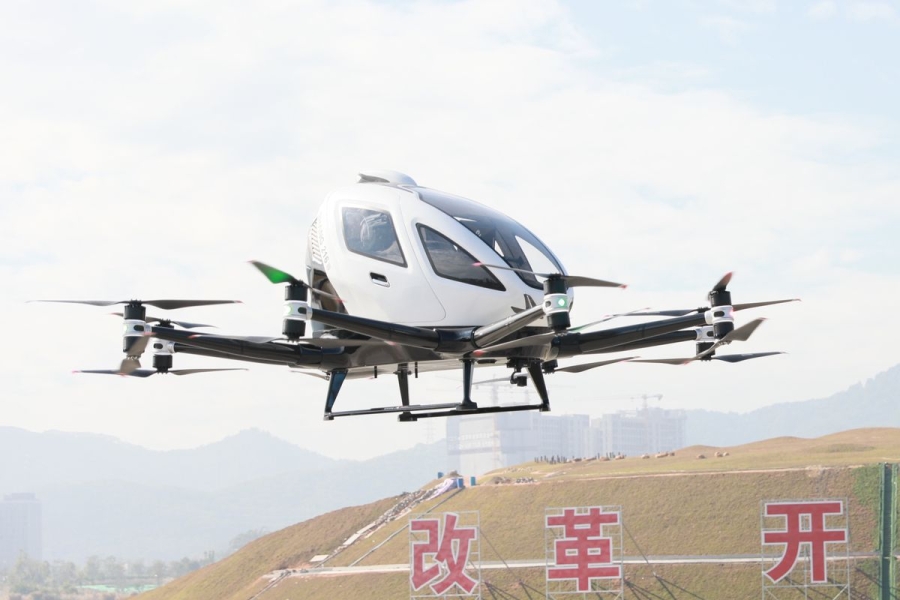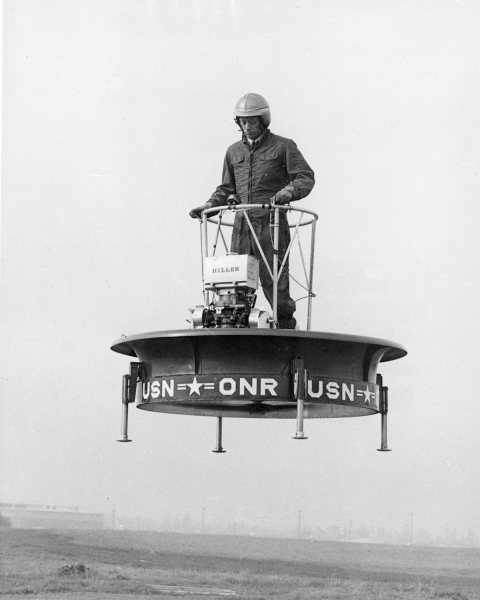The world had “flying cars” in the 1930s. We could be getting them again.

Dylan Matthews is a senior correspondent and head writer for Vox’s Future Perfect section and has worked at Vox since 2014. He is particularly interested in global health and pandemic prevention, anti-poverty efforts, economic policy and theory, and conflicts about the right way to do philanthropy.
On December 28 of last year, the Chinese firm EHang reached an important milestone. They flew a completely unmanned, autonomous passenger drone on its first commercial flight in Guangzhou. They were able to transport a human passenger without a pilot, using 16 different rotors and fueled entirely by an electric battery. It made for a much quieter vehicle than a typical helicopter and (in principle) a greener one, too.
If you want to be a little more whimsical about it (and not totally inaccurate), you could say that China has opened a flying car service. The EHang EH216-S can’t drive on a road, but it’s meant to be an airborne form of transportation as easy for ordinary people to use as an automobile.
Before you get too excited, here come the caveats. The EH216-S boasts a range of only 22 miles; by contrast, the most popular civilian helicopter model, the Robinson R44, can go up to 341 miles on a tank. The EHang has a top speed of only 81 mph; the Robinson can reach speeds up to 125 mph, even carrying a max weight of 818 pounds in people and baggage. And while the EHang doesn’t need a pilot, it can only carry two passengers compared to three (plus a pilot) in the Robinson. The EHang is certainly quieter and greener, and may prove to be safer (not that the notoriously accident-prone Robinson sets a high bar), but we’re a long way from phasing out ordinary helicopters, let alone seeing cars get replaced with little drone copters.
Still, I’m happy to see the little guy flying around Guangzhou — and while EHang specifically has been the subject of some financial controversy, I’m excited to see rivals like Joby, Wisk Aero, and LIFT’s Hexa also making progress. They serve as a reminder that some of the biggest questions about the future aren’t about what’s technologically feasible or economically feasible, so much as what’s socially feasible.
We can have a world full of flying cars — if we want it. But do we?
We had flying cars 100 years ago. Where’d they go?
The technologist J. Storrs Hall’s book Where Is My Flying Car? has become a bit of a cult favorite in Silicon Valley circles worried about technological stagnation. But it’s at its best when answering the literal title question: why haven’t we got flying cars yet?
The short answer is that we did get them. Hall argues we had functional flying cars as early as the 1930s. The aviation pioneers Juan de la Cierva and Harold Pitcairn developed an aircraft called the “autogyro” (also spelled “autogiro”). It wasn’t quite a helicopter: Autogyros had a rotor that twirled, but the rotor was unpowered, the thrust came from a separate engine, and the vehicles needed some runway to take off. But the vehicles could traverse long distances and some could even drive on regular roadways. They were, in that sense, true “flying cars” in a way the EHangs are not.
Autogyros had a brief moment in the sun. Pitcairn received a reward from President Herbert Hoover for his work, and an autogyro landed on the south lawn of the White House to mark the occasion. In the 1934 Frank Capra classic It Happened One Night, the rich antagonist pilots an autogyro to his estate. Amelia Earhart was a notable enthusiast, setting altitude records and writing a Cosmopolitan article headlined, “Your Next Garage May House an Autogiro.”
So, why aren’t any garages housing them today? Hall blames world events: During the Depression hardly anyone could afford cars, flying or otherwise, and during World War II whatever materials that could go into consumer autogyros were requisitioned for the war effort. By the war’s end, the autogyro had been usurped by the helicopter, which could take off vertically but was much too expensive and hard to operate to become a widespread personal conveyance.
The social barriers to a flying car world
Inventors tried to make planes and helicopters that could also serve as passenger cars or could be easily piloted by ordinary civilians. Hall runs through many of the candidates, from the Aerocar of 1946 (basically a tiny Fiat-look-alike car with wings on it) to the “Flying Jeep” of 1959. I particularly like the Hiller Flying Platform, a round structure with an engine at the bottom meant to fly infantrymen into battle:

(You can see this and several other flying car-like oddities at the National Air and Space Museum’s annex near Dulles Airport.)
Some — okay, many — of these designs had technical problems. But Hall insists the main barrier between us and flying cars has not been a lack of technical progress, or even high cost. He estimates that you could make an autogyro that works perfectly well as a flying car for about three times the cost of a luxury car. The problem, Hall writes, is that “cultural reaction and regulatory ossification have combined to dam up the normal flow of experimentation in high-power technology.” People have developed an “idiotic fear of energy” that keeps them from pursuing the future of our dreams.
Hall is right: The barriers to a world where passenger drones replace cars are social, more than technical. The Verge’s Andrew Hawkins notes that when EHang filed to go public four years ago, it cited as its largest risk a future collapse in public confidence in self-flying air taxis, likely due to a high-profile crash. Market bears betting against the company and other electric vertical takeoff/landing (eVTOL) firms argue that electric copters’ short ranges mean they can’t replace military or search-and-rescue helicopters, and that they will never be cost-competitive in the small market of urban transport helicopters: With heliports in New York charging usage fees in the range of $200 per flight, it’s never going to be cheaper to take a chopper than a cab to, say, LaGuardia Airport.
Will the public trust a self-piloted drone? How many heliports exist, and what do they charge per flight? How loud an air taxi fleet will residents of denser urban areas accept? These are all questions about our social attitudes, not our technical abilities. Even the range of the batteries or fuel cell systems in eVTOL aircraft is, to a degree, socially determined: Government subsidies for electric car batteries (especially in China) and green hydrogen play a huge role in how those technologies develop, and how efficient they’re able to get.
Where I differ from Hall is that I’m not sure the public’s attitudes here are as stupid as he makes them out to be. It’s fun to imagine an alternate America where, by 1990, every middle-class family had an autogyro, and road trips were replaced by gyro trips that took a fraction of the time and went much further.
But that America would be worse in important ways. It would have burned much more petroleum, speeding global warming and dirtying up the air; it would have been noisier; the skies would be congested, which, without dramatic improvement in our air traffic control abilities could’ve led to regular collisions much less survivable than those on our roads. I don’t look back at our decision (such as it was) not to create that world with the horror and regret that Hall does.
The good news is that the new range of eVTOLs promises to erase some of those tradeoffs. They can be quiet and carbon-free and piloted by AI systems less likely than humans to make dumb mistakes. We can choose that world by subsidizing it and clearing a regulatory path for it. But the technology alone won’t create that world. We have to actively make it.
Source: vox.com